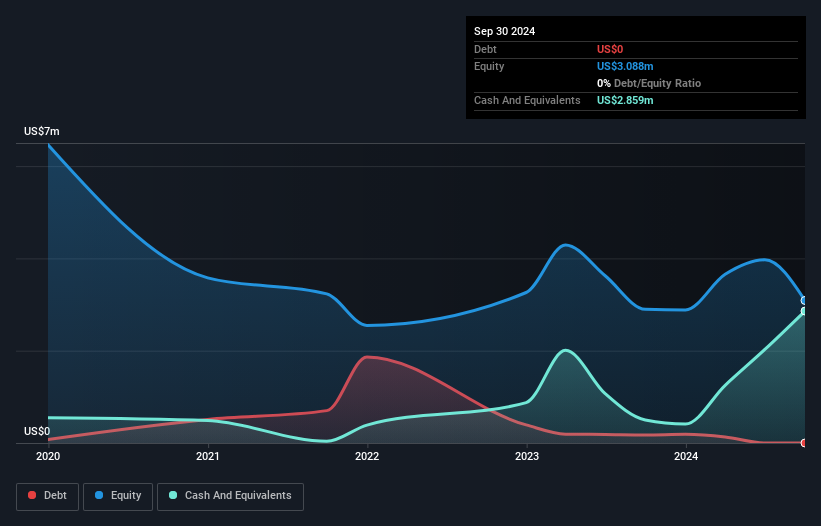We're Hopeful That Beyond Oil (CSE:BOIL) Will Use Its Cash Wisely
Just because a business does not make any money, does not mean that the stock will go down. By way of example, Beyond Oil (CSE:BOIL) has seen its share price rise 258% over the last year, delighting many shareholders. But while the successes are well known, investors should not ignore the very many unprofitable companies that simply burn through all their cash and collapse.
So notwithstanding the buoyant share price, we think it's well worth asking whether Beyond Oil's cash burn is too risky. For the purpose of this article, we'll define cash burn as the amount of cash the company is spending each year to fund its growth (also called its negative free cash flow). We'll start by comparing its cash burn with its cash reserves in order to calculate its cash runway.
See our latest analysis for Beyond Oil
How Long Is Beyond Oil's Cash Runway?
You can calculate a company's cash runway by dividing the amount of cash it has by the rate at which it is spending that cash. As at September 2024, Beyond Oil had cash of US$2.9m and no debt. Importantly, its cash burn was US$2.8m over the trailing twelve months. So it had a cash runway of approximately 12 months from September 2024. That's not too bad, but it's fair to say the end of the cash runway is in sight, unless cash burn reduces drastically. You can see how its cash balance has changed over time in the image below.

How Is Beyond Oil's Cash Burn Changing Over Time?
In our view, Beyond Oil doesn't yet produce significant amounts of operating revenue, since it reported just US$329k in the last twelve months. Therefore, for the purposes of this analysis we'll focus on how the cash burn is tracking. With the cash burn rate up 6.5% in the last year, it seems that the company is ratcheting up investment in the business over time. That's not necessarily a bad thing, but investors should be mindful of the fact that will shorten the cash runway. Admittedly, we're a bit cautious of Beyond Oil due to its lack of significant operating revenues. So we'd generally prefer stocks from this list of stocks that have analysts forecasting growth.
How Easily Can Beyond Oil Raise Cash?
While its cash burn is only increasing slightly, Beyond Oil shareholders should still consider the potential need for further cash, down the track. Companies can raise capital through either debt or equity. Many companies end up issuing new shares to fund future growth. By comparing a company's annual cash burn to its total market capitalisation, we can estimate roughly how many shares it would have to issue in order to run the company for another year (at the same burn rate).
Since it has a market capitalisation of US$75m, Beyond Oil's US$2.8m in cash burn equates to about 3.7% of its market value. Given that is a rather small percentage, it would probably be really easy for the company to fund another year's growth by issuing some new shares to investors, or even by taking out a loan.
So, Should We Worry About Beyond Oil's Cash Burn?
Even though its increasing cash burn makes us a little nervous, we are compelled to mention that we thought Beyond Oil's cash burn relative to its market cap was relatively promising. Cash burning companies are always on the riskier side of things, but after considering all of the factors discussed in this short piece, we're not too worried about its rate of cash burn. On another note, Beyond Oil has 5 warning signs (and 3 which are significant) we think you should know about.
Of course Beyond Oil may not be the best stock to buy. So you may wish to see this free collection of companies boasting high return on equity, or this list of stocks with high insider ownership.
Valuation is complex, but we're here to simplify it.
Discover if Beyond Oil might be undervalued or overvalued with our detailed analysis, featuring fair value estimates, potential risks, dividends, insider trades, and its financial condition.
Access Free AnalysisHave feedback on this article? Concerned about the content? Get in touch with us directly. Alternatively, email editorial-team (at) simplywallst.com.
This article by Simply Wall St is general in nature. We provide commentary based on historical data and analyst forecasts only using an unbiased methodology and our articles are not intended to be financial advice. It does not constitute a recommendation to buy or sell any stock, and does not take account of your objectives, or your financial situation. We aim to bring you long-term focused analysis driven by fundamental data. Note that our analysis may not factor in the latest price-sensitive company announcements or qualitative material. Simply Wall St has no position in any stocks mentioned.
About CNSX:BOIL
Beyond Oil
Develops and manufactures proprietary and patented formulation that reduces the fatty acids from cooking oil in Canada and France.
Flawless balance sheet with low risk.
Market Insights
Community Narratives



